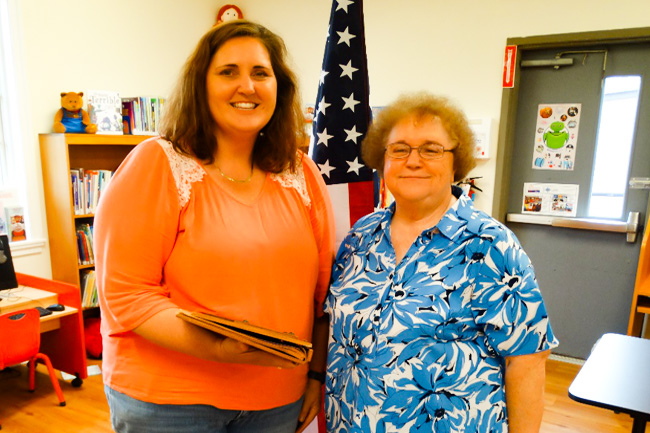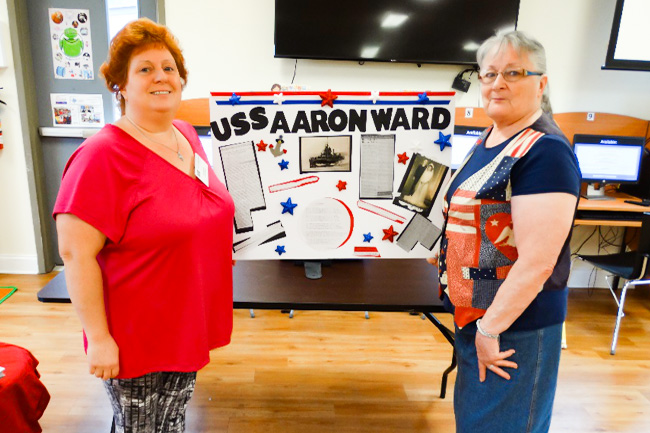Commemoration of D-Day at Parrott-Wood Library – June 4, 2019

D-Day is seared into the memories of older Americans as June 6, 1944, when every branch of the Allied Forces assaulted the beaches of Normandy, France, to stop the advancement of German forces during World War II.
The 75th Anniversary of the victory by the Allies was commemorated with celebrations around the world on June 6, 2019, and at Parrott-Wood Library, Strawberry Plains, on June 4 with a presentation by DAR Service for Veterans Chairman Carolyn Mitchell and Julie Wilbur, both members of the Martha Dandridge Washington Chapter (MDW), National Society Daughters of the American Revolution (NSDAR).
Ms. Mitchell began her presentation with some lesser known background on Adolf Hitler’s rise to power from his service in World War I where he was gassed, his trial for treason as a member of the National Socialist Workers’ Party (NAZI), his imprisonment during which he wrote Mein Kampf, and his re-founding of the Nazi Party which wormed its way into local offices and ultimately into the office of the President of Germany. It was Hitler who changed the name of the President to Fuhrer.
After the Empire of Japan, one of the Axis Powers, attacked Pearl Harbor on December 7, 1941, the United States soon declared war on Germany on December 11. German forces pushed east and west and south with a goal of swallowing up all of Europe and conquering the British.

The plans for the D-Day invasion called Operation Overlord were made with utmost secrecy and took years to develop. The Allied Commanders knew that the Germans were expecting an attack, but the Germans did not know when or where it would be. They suspected it would be at Pas de Calais where the distance between England and France is the shortest, and deception by Allied Forces by way of false radio transmissions and even a fake army kept them focused on that erroneous location. However, the Allied Command chose the beaches of Normandy to launch the attack even though the beaches were heavily fortified by the Germans.
Concerned that the Germans would discover the real details of the invasion, General Dwight Eisenhower was alarmed when bad weather forced a delay in the attack. However, after a one-day delay, the weather broke and the battle began.
According to information from the National D-Day Memorial, more than 150,000 troops and paratroopers from the U.S., Britain, and Canada participated in the invasion. More than 5,000 ships and 11,000 aircraft supported the invasion during which more than 9,000 American, British, and Canadian soldiers were killed or wounded. Although the losses were heavy, those brave warriors made it possible or the Allies to establish a foothold on the continent and drive the Germans back to their borders and to ultimate defeat.
After Nazi Germany invaded Poland in 1939, Ms. Mitchell’s uncle Sergeant First Class Clifford Wright of the Tennessee National Guard joined the regular U.S. Army on December 5 and became a drill instructor. He was stationed at Fort Jackson, SC, when the Japanese attacked Pearl Harbor.
SFC Wright’s unit landed on Omaha Beach on D-Day plus 4 (June 10) in heavy rain, so they could not climb the cliffs. No plan had been executed to disable the German guns, so after the first waves of Allied soldiers passed, the Germans returned to their guns and shelled the beaches. There was nowhere to shelter, so they spent the night on the beach under their panchos with their fingers in their ears as ammunition rounds hit around them.
Ms. Mitchell shared some little-known facts about the invasion that surprised her audience. Five weeks before D-Day, Operation Tiger was undertaken as a dress rehearsal for the invasion. At Slapton Sands, southwestern England, the practice invasion cost 1,000 American lives. When the Germans saw the assembled landing craft and ships, they and attacked and caused the deaths of 700. Then during the actual attack, live ammunition was used by the Allies to make the battle realistic. When the men hit the shore, the shelling was supposed to stop, but due to a timing mix-up, the fire continued and another 300 died. The loss of life had to be kept secret so as not to disclose the coming actual invasion of Normandy.
The National D-Day Memorial in Bedford, VA, features a memorial wall with the names of the 2,499 U.S. service members who died in the invasion on the western wall and the names of the 1,914 allies who died on the eastern wall. A reflecting pool with statues that represent the beach landing and fighting is located in Gray Plaza, and the 44½ foot high Overlord Arch stands in Estes Plaza. Bedford is the community that suffered “the highest per capita D-Day losses in the nation.”
Ms. Mitchell shared her paternal grandmother’s scrapbook inscribed “Christmas Day 1943 – This book was given to me today by Clifford, my only son at home this Christmas. This day was enjoyed by all present but saddened by the ones absent.” Then it listed those present. Clifford later served with the 30th Infantry Division, known as the “Old Hickory Division” during the Normandy invasion and the Battle of the Bulge. The book contains clippings from The Knoxville Journal that follow the movements of the unit up through the liberation of the Dachau concentration camp and on to Berlin.
With all of the focus on the invasion in Normandy, one must not forget that the war was being fought in the Pacific, as well. Ms. Mitchell’s father Corporal Wallace Wright served in the Pacific Theater in the U.S. Army Signal Corps as a radio communications operator who sent and received messages in Morse Code. His unit island hopped attacking the Japanese forces entrenched there.
At this point, Julie Wilbur took over the presentation to share the story of her father First Class Machinist’s Mate Willard H. Duncan’s service on the USS Aaron Ward in the Pacific Theater. After he graduated from high school, he joined the U.S. Navy and was stationed in Honolulu. Ms. Wilbur always wondered why her father was not on ship when the Japanese attacked Pearl Harbor. By doing research on Fold3.com, a database of military records, she learned that he had left Honolulu for San Diego aboard the Matsonia on October 31, 1941, in order to go on to submarine school in Connecticut. He met Julie’s mom Bess Lawracy in New York City during that time.
The destroyer USS Aaron Ward was launched in 1942 and sunk at Guadalcanal on April 7, 1943. According to the Destroyer History Foundation website, the ship was attacked by several Japanese dive bombers, suffering one hit and several near misses that left her machinery spaces flooded. She sank while under tow back to Tulagi. Duncan married Ms. Lawracy while on Survivor’s Leave in New Jersey.
Then on September 4, 1994, the wreck of the Aaron Ward was discovered. Duncan was contacted by a member of the exploration team who asked him to write down his memories. Duncan did write them down, and Ms. Wilbur cherishes his account. Until then, Duncan, who suffered from PTSD (although they did not call it that then) never wanted to talk about his time in the war. Ms. Wilbur said one thing she did know was that “you never wanted to sneak up on Dad.”
After his discharge from the service, he became a Conservative Baptist minister and reared eight children. While in the service, he was given the nickname “Deacon” because no matter where he was stationed, he always looked up a Christian church to visit. Ms. Wilbur remembered her dad liked to sing. He also wrote the following poem:
In Memoriam
By William H. Duncan
1942
For us there’ll be no crosses row on row,
Nor in some foreign field will poppies grow,
A token of our valiant lives misspent,
Of homes and families, grief and sorrow rent:
Only the cold depths of some ocean grave
Marked by the white caps of the ocean wave
Will be the resting place of such as we
Who fight our country’s battles on the sea.
We know not where or when our time will come
While fighting valiantly, our day is done;
But in the hearts of those we’ve left behind –
In those dear hearts of loved ones we will find
A resting place in mem’ries ever green,
With hopes and dreams of things that might have been;
And, so, in times to come when this war’s oe’er
And peace does reign again from shore to shore.
Let not our shattered hopes be spent in vin
As those of yesteryear, and war again;
But let our sacrifice forever be
A light for peace through all eternity.
President George W. Bush sent Duncan a certificate recognizing his devoted and selfless service.
The D-Day Commemoration program was attended by people from the community including Jefferson County Mayor Mark Potts.











